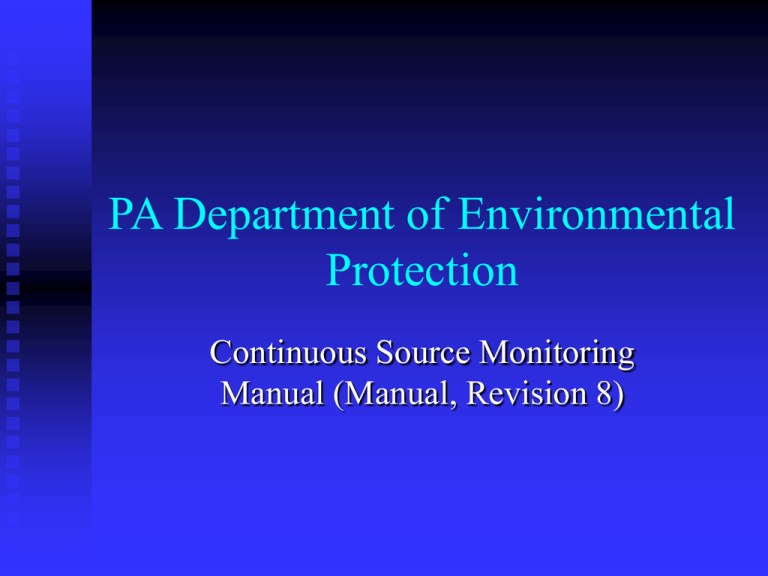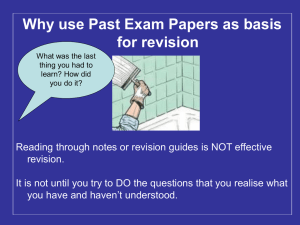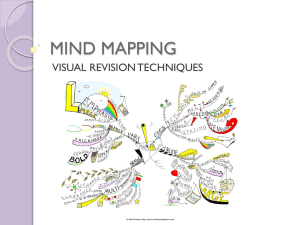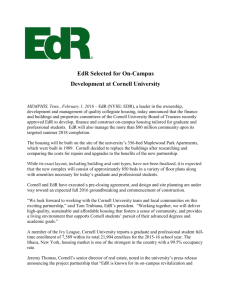Revision 8 – Continuous Source Monitoring Manual (CSMM)
advertisement

PA Department of Environmental Protection Continuous Source Monitoring Manual (Manual, Revision 8) Background In September of 2003, the Department released Revision 7 of the Manual after a multi-year discussion with affected stakeholders on the appropriate changes. In the fall of 2003, the Department issued a contract to Perrin Quarles Associates, Inc. (PQA) to develop a study of the impacts of harmonizing the Manual requirements with those of other applicable federal and regional programs. The need for the study was identified, as a cooperative effort, between the Department and the Air Quality Technical Advisory Committee (AQTAC). Background (Cont.) The study examined PADEP, regional, and federal CEM requirements in depth and provided a technical basis for future changes in the Manual and the program. Development of Manual Revision 8 The AQTAC Technical Workgroup met on six occasions between October 2004 and March 2005 to develop a finalized draft of Revision 8 of the Manual. The AQTAC concurred (at their June 16, 2005 meeting) with the Department’s recommendation to publish the notice of availability of the draft revisions to the Manual and request public comments. Development of Manual Revision 8 (Cont.) The Department accepted public comments pertaining to Revision 8 of the Manual and the corresponding applicability determination (September 9, 2005 – October 31, 2005). The Technical Workgroup met in February and March of 2006 to review the Department’s responses to comments received during the public comment period and other outstanding issues. Development of Manual Revision 8 (Cont.) The Technical Workgroup met on April 26, 2006. Concurrence with the Department’s recommendation to present the draft version of the Manual and the corresponding Applicability Determination (with a few minor modifications) to the AQTAC was given. On April 27, 2006, the AQTAC concurred with the Department’s request to finalize the documents and notice in the PA Bulletin. Summary of Major Changes from Revision 7 to 8 of the Manual Significant changes were made in the following sections of the CSMM: Introduction Submittal and Approval Initial Application Tables (Phase 1) Performance Testing (Phase 2) Record Keeping and Reporting Quality Assurance Attachments Major Changes (Cont.) Introduction Explanation of terminology change to Part 75 definitions for performance specification (PS) testing. Submittal and Approval Addressed changes to process operational conditions that could require additional monitoring approvals. Initial Application Tables (Phase 1) Include requirements for “highest” and “optional lower” ranges. Eliminated requirements for 2-hr drift testing. Major Changes (Cont.) Sources may petition (in many instances) to use either a more stringent applicable federal requirement or less stringent applicable federal requirement with proper justification. Added an alternative 2 PPM calibration error specification. Major Changes (Cont.) Performance Testing (Phase 2) Changed the language for PS testing to be more consistent with federal requirements. Record Keeping and Reporting Language added to explain the reporting of “substitute” data and when the use of “monitoring not required” is allowed. Language to explain information to be reported relative to tests, audits, recalibrations, delinquency penalties, timeliness issues and potential consequences. Major Changes (Cont.) Quality Assurance Changed requirements for addressing “infrequent operation/extended outage/shutdown.” Provisional validation of data. Language added to make data validation and data reduction provisions more consistent with federal requirements. Added language to explain invalidation of data by the Bureau if reports are not submitted in a timely manner. Major Changes (Cont.) Changed language with respect to notifications and testing required due to component maintenance or replacement. Changed language to make provisions for “operating hours exemptions” and “grace periods” more consistent with federal requirements. Added language relative to determination of compliance with “stack” flow measurement device installation specifications for “leak checks.” Major Changes (Cont.) Attachments Reference latest versions of PS 1 and PS 2. New PA EDR Version 2.00 Record Type Formats and Reporting Instructions. New Recertification Guidance. PA EDR Version 2.0 DEP’s existing, custom electronic emission data reporting formats have been in use for more than 20 years. Were developed prior to EPA's institution of EDR formats for the Acid Rain and NOx Budget Programs. Program restraints allow only very limited use of existing EPA EDR emission record elements. During the fall and winter of 2005, the Department accepted and reviewed requests for proposals to develop a new CEM Data Processing System (CEMDPS). PA EDR Version 2.0 (Cont.) In April 2006, the Department awarded the contract to develop a new CEM Data Processing System (CEMDPS). Because of the complexity involved with harmonizing the numerous PADEP and federal requirements for roughly 1,000 CEMSs, the incorporation of a new PA Electronic Data Reporting Format (PAEDR 2.00) is integral to handling the changes proposed for the Manual. Where Do We Go From Here? • • • Finalize changes and publish in the PA Bulletin in June or July of 2006. Ongoing development and testing of the new CEMDPS. Implementation delay (June or July of 2006 until the first day of the second quarter after the new CEMDPS has become functional). Summary Revision 8 of the Manual was developed through a cooperative effort between the Department and the AQTAC. Changes to the Manual were made in an effort to harmonize requirements of multiple programs, provided that such changes were appropriate for achieving the accuracy necessary to provide credible data from CEMS subject to those programs. Implementation the Manual and the new CEMDPS will occur simultaneously. The Department anticipates that the effective date of the new Manual and CEMDPS will occur during the fall of 2007 or first quarter of 2008. Questions?











